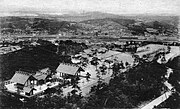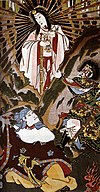Chōsen Jingū
The famous architect and architectural historian Itō Chūta, also responsible for Meiji Jingū, contributed to its planning.
The former site of the shrine is now part of Namsan Park.
Background

After the annexation of Korea in 1910, the Japanese government embarked upon a policy of Japanization. This included worship at Shintō shrines, as much a political expression of patriotism as a religious act. From 1925, school pupils were required to attend Shinto shrines, and in 1935 it became compulsory for university students and government employees to attend Shinto ceremonies. By 1945, there were a total of 1,140 shrines in Korea associated with State Shinto.
Ogasawara Shozo was an advocate for attempting to use the concept of Okunitama to syncretize Japanese and Korean religion. Some people identified Dangun with Susanoo-no-Mikoto, the government not wanting to take a stand on this enshrined the generic Okunitama at Chōsen Jingu so believers could have their own interpretations. Ogasawara Shozo was a strong advocate of these positions and his advocacy was associated with the enshrinement of Okunitama at both Chōsen Jingu, and Keijō Shrine.
State authorities at Chōsen Jingu however never even allowed for Okunitama to be called "Chosen Okunitama" and indigenous Dangun traditions were suppressed in favor of worshipping Amaterasu in the shrine.
History
The shrine was constructed in 1925, and an enshrinement ceremony held in October. It was dedicated to Amaterasu and Emperor Meiji. It was constructed in the shinmei-zukuri style of Ise Jingū.
Worship at the shrine increased in the 1930s after the government began forcing people to attend. This made the shrine and others a target of resentment; within days of Korea's liberation in 1945, many shrines were burnt down.
An ethnic Korean group proposed to take over Okunitama worship after the war and convert the shrine to one worshipping Dangun but was denied by the new government. Ogasawara also proposed a system where Japanese people in the colonies were seen as Amatsukami and natives were seen as Kunitsukami.
After the announcement of Japan's surrender on August 15, a ceremony was held that afternoon to remove the enshrined deities. The shrine was considered by the United States Army Military Government in Korea to be "enemy property".
Chōsen Jingū was demolished in October 1945. The former site of the shrine is now part of Namsan Park. In 1970 the "Patriot An Jung-geun Memorial Hall" was constructed on the site of the former shrine, in honour of An Jung-geun, the assassin of Itō Hirobumi, the first Japanese Resident-General. A statue of another independence activist, Kim Ku, was also erected on the spot.
Description
The shrine ran along a straight axis of around 500 meters (1,600 ft). The main shrine was at the far end away from the entrance.
Gallery
See also
References
- ^ Sung-Gun Kim (1997). "The Shinto Shrine Issue in Korean Christianity under Japanese Colonialism". Journal of Church and State. 39 (3): 503–521. doi:10.1093/jcs/39.3.503.
- ^ Wakabayashi, Ippei. "Ahn Jung-geun and the Cultural Public Sphere" (PDF). Bunkyo University. Archived from the original (PDF) on 13 June 2011. Retrieved 31 March 2011.
- ^ Grayson, James H. (1993). "Christianity and State Shinto in Colonial Korea: A Clash of Nationalisms and Religious Beliefs". Diskus. 1 (2). British Association for the Study of Religions: 13–30. Archived from the original on 5 September 2011. Retrieved 27 April 2011.
- ^ Wagner, Edward W.; et al. (1990). Korea Old and New: A History. Harvard University Press. p. 315. ISBN 0-9627713-0-9.
- ^ Kōji, Suga; 𨀉𠄈 (2010). "A Concept of "Overseas Shinto Shrines": A Pantheistic Attempt by Ogasawara Shōzō and Its Limitations". Japanese Journal of Religious Studies. 37 (1): 47–74. ISSN 0304-1042. JSTOR 27822899.
- ^ "東アジアの都市における歴史遺産の保護と破壊――古写真と旅行記が語る近代――". www.gakushuin.ac.jp. Retrieved 9 October 2023.
- ^ "Chōsen Jingū". Genbu.net. Retrieved 31 March 2011.
- ^ Hiura, Satoko (2006). "朝鮮神宮と学校 : 勧学祭を中心に". Japan Society for the Historical Studies of Education. 49. National Institute of Informatics: 110–112.
- ^ Keene, Donald (2002). Emperor of Japan: Meiji and his World, 1852-1912. Columbia UP. pp. 664ff. ISBN 9780231123402.
- ^ Grisafi, John G (September 2016). "Shintō in Colonial Korea: A Broadening Narrative of Imperial Era Shintō". Academia.edu. University of Pennsylvania. Retrieved 13 June 2023.
External links
(in Japanese) Chōsen Jingū (plan and photographs)
- 1931 photograph Archived 4 March 2016 at the Wayback Machine





